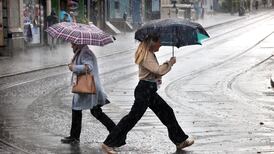ANOTHER LIFE:FROM THE PURPLE patches of heather and wild thyme at its rocky turning, the boreen to the sea is a flower-shop of old reliables - fuchsia, honeysuckle, purple loosestrife, meadowsweet twined with vetch - and others I always need to look up: red-flushed St John's wort, yellow spikes of agrimony, writes Michael Viney.
But then, where the ford used to be, a glorious surprise: orchids bristling on the dry river bank, most of them pinkly common and spotted and, spaced out among them, a score of ivory spires of the greater butterfly orchid, queen of them all.
How it got to be the butterfly orchid, when its luminous whiteness and ravishing night-time scent are so precisely aimed at pollination by moths, I've no idea. Even Gaelic Ireland, quick to agree with the Greeks that the twin bulbs of many orchid roots resemble testicular magairlín, was happy to tag on an fhéileacáin. Most Irish orchid names are, indeed, straight translations from the English, though I like it that the early purples of spring are meidhreach, or merry, and that the pyramidal orchid, magairlín an stuaice, reminded people of corn-stooks rather than dead pharaohs.
An early volume of this chronicle discloses that the last time I wrote of butterfly orchids "in drifts of dozens in grassy places where I have never seen them before" was in July, 1985. Both greater and lesser butterfly orchids can carry the erratic flowering of their plant tribe to a notorious extreme.
Brendan Sayers, the orchid expert of the National Botanic Gardens, notes cautiously that: "Observers have stated that a plant can be present without flowering for more than 20 years." So, such an interval is quite possible, but so is my inattention in summers in between; even now, it was visitors who spotted the orchids first, and kindly came to tell me.
The growth of Ireland's orchids is often a chancy and protracted affair, given their dust-fine seeds and the need to find food in lean places - this achieved with the help of co-operative underground fungi called mychorrhiza. It can take at least three years for a germinated butterfly seed to form a tuber and push its first leaf above ground, and many more before it has the energy to flower. All this needs a stable habitat, like this old grassy river bank behind the shore, regularly sifted with limy, wind-blown sand.
The other big factor that complicates the lives of orchids is that their pollinators are almost entirely insects, sometimes very specific ones, to which their flower-structures, colours and scents have been engineered in the process of co-evolution. Some species, like Ireland's bee and fly orchids, imitate the insects sufficiently well to invite copulation and even exude scents that mimic their female pheromones.
Why humans should find so many orchid scents so pleasurable is one of life's little mysteries (there are, on the other hand, some - mainly tropical - that smell of moth-balls or carrion, with very specific intent).
And while not all the insect-mimics reward their pollinators with nectar, the greater butterfly orchid not only offers a scent as sweet and room-filling as freesias, but a generous supply of nectar, kept in the long, narrow spur that extends from the base of the flower's lip.
It was Charles Darwin who spotted how specifically the length of an orchid's spur may be matched to the tongue of a particular moth.
Scientists are still studying the difference in spur-length of the greater butterfly orchid, and the lesser species with its smaller flowers, in the hope of discovering which moths have played a part in maintaining the evolutionary gap between the two. But the British discovery that the spurs of both species seem to vary in length between England, Scotland and Sweden, perhaps through regional adaptation to different pollinators, had Irish orchid-fanciers out with their rulers last summer, measuring to the nearest millimetre. My own sampling suggests that the spurs on Mayo's greater butterflies (typically around 23mm, against Scotland's 27mm) may be the smallest of all.
To see great photographs of the orchids and hundreds of other Irish blooms, try a new website, www.irishwildflowers.ie, compiled by Jenny Seawright of Macroom, Co Cork, and grant-aided by the Heritage Council. Lots of sound information on species and habitats and what to look for month by month.
Also from Co Cork, from the man who gave us the splendid interactive website, www.biology.ie, Paul Whelan of Cobh, is another resource well worth exploring, www.lichens.ie. Along with orchids, this humid summer has plumped up Ireland's lichens to their colourful, richly patterned, texture-filled best.
EYE ON NATURE
I saw an amazing sight at Capel Street Bridge: a big seagull with an orange beak with a fist-sized crab fighting for existence as traffic crawled by. The seagull, oblivious, enjoyed lunch witnessed by vehicle-bound spectators.
Andrew Conway, Bushy Park Road, Dublin 6
A large animal, about the size of a badger, ran past our window and down the lawn. It had large haunches and much shorter front legs, a long tail, a snout and a shiny black coat. It was a bit like an otter, but an otter should be browner and smaller. We have no stream or river near us.
Donal Clarke, Cahore, Co Wexford
It was a wet otter on its way somewhere.
I used to fish regularly and occasionally threw out some seaweed containing a few sand hoppers into the garden. Two years ago I noticed some sand hoppers under a pot on the patio and since then their numbers have increased rapidly until now they are under every stick and pot and in every fork of clay that I turn over. They appear to be the species Talitrus Saltator.
Brian Hackett, Cabinteely, Dublin 18 These crustaceans need moist conditions in which to burrow and a supply of decaying vegetation to survive.
Michael Viney welcomes observations at Thallabawn, Carrowniskey PO, Westport, Co Mayo; e-mail: viney@anu.ie Include a postal address









